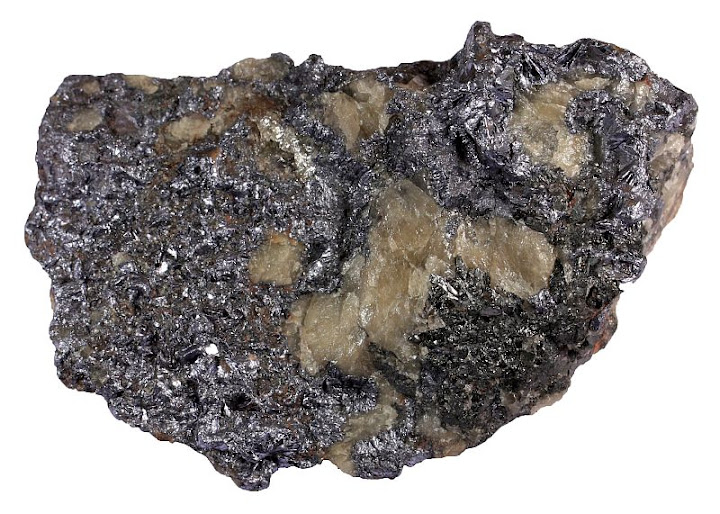Molybdenite (MoS2) is a principal source of molybdenum. It is a sulfide mineral (molybdenum sulfide). Molybdenite occurs in hydrothermal vein deposits and as disseminated grains in rocks which have been attacked by hydrothermal fluids (porphyry moly and copper deposits). It may also occur in pegmatites and skarns. Associated minerals are quartz, pyrite, chalcopyrite, fluorite, anhydrite, etc.

Metallic gray mineral with calcite (blocky gray), pyrite (greenish crystals in the upper part), and serpentinite (green in the background). Phillippsburg, New Yersey, USA. Width of sample 8 cm. TUG 1608-3216.
It has a metallic luster and steel gray color. It resembles graphite, both are very soft minerals and therefore have a greasy feel to the touch, but its crystals have a clear bluish tone. Molybdenite has a slightly greenish streak on an unglazed porcelain while graphite is black. It has one perfect cleavage and the folia are inelastic.
Molybdenite is the principal ore of molybdenum, which is mostly used to make high-strength steel. Molybdenum is also a micronutrient, so it is added to fertilizers and also to the dietary supplement pills. High doses of it are toxic.

With quartz from Altenberg, The Ore Mountains, Germany. Width of sample 8 cm. TUG 1608-6160.
Nice specimens! My only practical experience in “hard rock” was a summer job in my undergrad days, exploring for moly in southern British Columbia. The best shows we ever found were a few small flakes, maybe up to 10 mm across. My boss would have freaked if we found samples like those in your photos!
Yep, these are pretty nice specimens. What I want to achieve with Sandatlas project among other things is to show how rocks really look like. There are already plenty of websites that show beautiful but extremely rare well-developed crystals. However, with nice specimens I am somewhat violating this rule of mine 🙂 But some copromises have to be made because how do you learn to understand how mineral looks like if there are only microscopic flakes visible? I will add photos to old articles also if I will make new photos. In the long run they should contain much more (possibly thin section and SEM photos, outcrops, etc.) that they do now. Let’s see how long I have a desire to do this never-ending job.